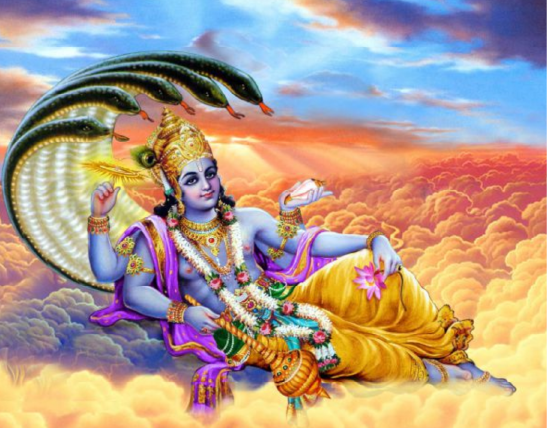Learning to Chant Vishnu Sahasranamam
(Children of age 6 and above, and adults of all ages)
Every Monday and Wednesday
7:00pm to 8:00pm

We are delighted to start the "Learning to Chant Vishnu Sahasranamam" Classes Online starting 4/17/23, Monday, 7pm, and will happen every Monday and Wednesday 7PM over the course of 10 weeks.
Teachers:
Sri Harikrishnan Vijayachandran &
Sri Shashi Bhargava (Mid-May onwards)
Fee: $30 for the entire course
Please use this link for making online payment for this course: bit.ly/vsnhtor
Or, scan this QR code:

Register for Classes:
Contact: 505-355-8100 for registration or Registration can be made by sending an email to education@htor.org
Email: If you have any questions please email education@htor.org with your contact info. We will get back to you.
Vishnu Sahasranamam Classes - Every Monday and Wednesday @ 7:00 P.M.
From: April 17, 2023 till June 14, 2023
Join Recurring Zoom Meeting
Time: 07:00 PM Eastern Time (US and Canada)
https://us06web.zoom.us/j/82822763935?pwd=bUlEem5jMm5iRG14L29FeENDM0NFUT09
Meeting ID: 828 2276 3935
Passcode: 1Z7cj4
From: April 17, 2023 till June 14, 2023
Join Recurring Zoom Meeting
Time: 07:00 PM Eastern Time (US and Canada)
https://us06web.zoom.us/j/82822763935?pwd=bUlEem5jMm5iRG14L29FeENDM0NFUT09
Meeting ID: 828 2276 3935
Passcode: 1Z7cj4
Those who have registered for the course , can join this VSN WhatsApp Group for any further communication:
About the Vishnu Sahasranama:
The "Sahasranama" is a popular genre in stotra literature wherein a deity is remembered by a 1000 epithets. The Vishnu Sahasranama is without doubt the most famous of all "sahasranamas".
It is arguably one of the two most widely sung Sanskrit songs in India along with Venkatesha Suprabhatam.
However unlike Venkatesha Suprabhatam, which is a 15th century composition, the Vishnu Sahasranama is a very ancient stotra found in many ancient texts including Mahabharata, Padma Purana, Skanda Purana, and Garuda Purana.
The version that is most famous is the one found in Anushasana Parva, the 13th book of the great Itihaasa text - Mahabharata, authored by Veda Vyasa, as per tradition
So by a conservative estimate, the stotra is atleast a couple of thousand years old, given that Mahabharata's current redaction is dated to roughly the period ~300BCE to ~400CE.
The Anushasana Parva is the book in Mahabharata that follows the themes explored in the preceding Parva - the "Shanti Parva". Like Shanti Parva, the 13th book also takes the form of a dialogue between Yudhishtira and Bhishma after the Great Kurukshetra War
The Vishnu Sahasranama stotra features in the 149th chapter of Anushasana Parva.
It begins with Yudhishtira posing the great Bhishma (who is lying on his bed of arrows) the question -
किमेकं दैवतं लोके किं वाप्येकं परायणम् ।
स्तुवन्तः कं कमर्चन्तः प्राप्नुयुर्मानवाः शुभम्
को धर्मः सर्वधर्माणां भवतः परमो मतः ।
किं जपन्मुच्यते जन्तुर्जन्मसंसारबन्धनात् ॥
"In this universe Who is the one refuge for all? Who is the greatest Lord in the world?
By eulogising whom can a person reach auspiciousness?
What is, in thy opinion, the Greatest Dharma of all Dharmas?
By chanting whose name, can a "creature" proceed beyond the bonds of samsāra?
Bhishma responds with the great Tatpurusha compound "Vishnu Sahasranama" - the thousand names of the Supreme being Vishnu - and advocates the devotees to completely take refuge in the lord whose attributes are described in VS.
The Sahasranama is a very early example of Bhakti literature, which describes with great elan the attributes of the supreme Brahman. The Supreme being is very much a Saguna brahman (a god with attributes).
Let's take a sample of 4 names from the Sahasranama -
विश्वम् : One who contains the universe in him
विष्णुः : One who pervades the universe
अक्षरः One who is ineradicable
शिवः One who is eternally auspicious
These names do suggest that the brahman in question here is "Saguna"
Having said that the Sahasranama has attracted commentaries from all schools of Vedanta including the Advaita school of Sankara who subscribes to the Nirguna Brahman.
The major commentaries are -
- Adi Sankara's Bhashya : 8th century (Advaitin commentary)
- Parasara Bhattar's Bhashya : 12th century (Vishishtadwaita commentary)
- Madhvacharya's Bhashya : 13th century (Dvaita commentary)
The theology of the Sahasranama also varies by commentary. While Parasara Bhattar and Madhva predictably have no ambiguity in associating the Supreme being with Vishnu, the Advaitin Sankara notes that "shivah" is one of the thousand names. Hence Vishnu and Shiva are equivalent
The Vishnu Sahasranama remains a classic of the whole genre and it still amazes us with its metrical perfection and the remarkable imagination of the poet in envisioning the attributes of the supreme being.
